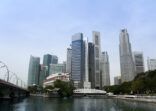It is just a matter of time before China rolls out compulsory ESG disclosure requirements, although rumours that Beijing is due to announce its plans imminently will likely prove wide of the mark as all eyes remain firmly fixed on the International Sustainability Standards Board (ISSB).
That is the view of market observers ESG Clarity Asia spoke with following media reports last month that regulators in China had been sounding out advisory bodies and rating agencies to formulate a framework for mandatory ESG-related disclosures.
China has made no secret of its desire to eventually adopt mandatory disclosure requirements with the China Securities Regulatory Commission (CSRC) vice-chair Fang Xinghai describing it as the “next step” last year.
Although, the ISSB has agreed on the final content of IFRS 1 and 2 and will publish these by the end of the second quarter, the chair of the board Emmanuel Faber confirmed in February.
China has been very much involved in those developments and one of the vice-chairs of the ISSB is Jingdong Hua, a Chinese national who previously served as vice-president and treasurer of the World Bank, so any suggestion that they might jump the gun by introducing their own requirements beforehand is unlikely.
“The whole conversation about mandatory ESG disclosures in China has been going on for a very long time even before I started working in the industry,” said Jingwei Jia, associate director for ESG Research at Sustainable Fitch.
“We have to be patient and see how the direction is going to go this year. It’s also been clear that the CSRC and other regulators are probably trying to adapt the rules from the ISSB so it’s likely that we will have to wait for that first.”
Lay of the land
The current ESG reporting requirements for Chinese companies are scanty with the only current mandatory requirement having been introduced in February last year by the Ministry of Ecology and Environment.
Those rules require companies that are considered to be major emitters of pollutants and publicly traded companies that have been penalised for environmental violations within the past year to provide a range of environmental information annually.
In reality, the number of companies that already issue ESG reports is fairly high, particularly among the large-cap companies, either because they are listed overseas and are subject to mandatory reporting requirements in different jurisdictions or because they are merely aiming to follow best practice internationally.
According to a report from KPMG, 89% of China’s top 100 companies issued ESG reports last year, up from 78% in 2020.
Probably the biggest development in recent years was in June last year when the China Enterprise Reform and Development Society, a think tank overseen by the state-owned Assets Supervision & Administration Commission, along with several companies such as PingAn Insurance issued voluntary guidelines for ESG reporting.
The guidelines set out a framework for Chinese companies to report under three primary indicators of ESG metrics, which are further divided into 10 secondary indicators, 35 tertiary indicators and 118 total metrics.
Market observers noted that those requirements could provide a useful benchmark for when the CSRC and other regulators eventually develop their own mandatory requirements, although they bemoaned the lack of take up so far.
“I looked at it last year and I thought it sounds interesting that they came out with this framework, but the proof is in the pudding,” said Xuan Sheng Ou Yong, green bonds and ESG analyst at BNP Paribas Asset Management. “Unfortunately, besides the initial announcement, I haven’t seen any other reference to this standard by Chinese companies.”
All eyes on the ISSB
So what will any mandatory requirements by the Chinese regulators look like? In this regard, the voluntary disclosure guidelines from the China Enterprise Reform and Development Society should provide a helpful signpost given their references to China-specific characteristics such as common prosperity and rural revitalisation.
According to Alexander Chan, head of ESG client strategy for Asia Pacific at Invesco, in addition to the reference to Chinese characteristics, there are two other major differences between the voluntary guidelines and international standards.
One other difference, he said, is that the voluntary guidance was more focused on reporting metrics, whereas most international frameworks focus also on the broader disclosure framework. Second, the voluntary guidelines are more focused on providing a current snapshot, whereas most international requirements also focus on forward-looking assessments such as transition plans.
According to market observers, the mandatory requirements that are eventually brought in by the Chinese regulators will likely seek to harmonise both international standards and the current voluntary guidelines but references to Chinese characteristics will be key.
“We have to think about how regulations are set up and what’s the purpose of them,” said Sheng. “It’s to inform investors and it’s not just foreign investors that Chinese companies have to inform. They also have to inform their local stakeholders, their local investors, which is the majority of their capital base.”
But the most important characteristic, according to market observers, will be interoperability with the ISSB’s standards hence the likelihood that regulators will wait until they are published this quarter.
“Globally the belief is that if you want to promote interoperability and you want to facilitate standardisation then waiting for the baseline standards becomes a lot more helpful,” said Chan.
This story first appeared on our sister publication, ESG Clarity.

















